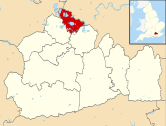Kempton Park Steam Engines

The Kempton Park Steam Engines (also known as the Kempton Great Engines) are two large triple-expansion steam engines, dating from 1926–1929, at the Kempton Park waterworks, London. They were manufactured by Worthington-Simpson. Each engine is of a similar size to that used in RMS Titanic and rated at about 1008 hp. They each pumped 19 million gallons of water a day, to supply north London with drinking water taken from the River Thames. They were the last working survivors when they were finally retired from service in 1980.
The engines are of an inverted vertical triple-expansion type, 62 feet (19 m) tall from basement to the top of the valve casings and each weighing over 800 tons. The engines are thought to be the biggest ever built in the UK.
One of the engines, called The Sir William Prescott, has been restored to running order and is the largest fully operational triple-expansion steam engine in the world. It may be seen in steam on various weekends during the year. The engine house also houses two steam turbine water pumps.
The waterworks is adjacent to the A316 (just before it becomes the M3 motorway), between Sunbury-on-Thames and Hanworth. The same site also features a 2-foot gauge steam railway, the Kempton Steam Railway, the largest steam railway offering rides to the public on selected days,[1] in London.
The steam engines now form a museum operated by Kempton Great Engines Trust, a registered charity.[2]
See also
Media
- The 1971 top-ten chart hit "Tap Turns on the Water", by British band CCS, was choreographed for BBC dance troupe Pan's People at the pumping station.[3]
- The engines were featured in both Titanic films, "A Night To Remember" (1958) and the made-for-TV film "S.O.S. Titanic" (1979). The engines are very similar to the actual engines on board the Titanic albeit the Titanic's engines were 4 cylinders as opposed to three. Yet the Kempton engines are the correct size (4 stories tall) and of the correct type (triple expansion). Alas, land based pumping engines, Like Kempton Park's engines have flywheels: Marine Steam Engines have no flywheels.
References
- ↑ Opening dates 2014
- ↑ Charity Commission. Kempton Great Engines Trust, registered charity no. 1048936.
- ↑ "Pan's People – Tap Turns On The Water". Oneforthedads.org.uk. 14 March 2015. Retrieved 1 November 2015.
External links
Coordinates: 51°25′33″N 0°24′18″W / 51.4259°N 0.4050°W
